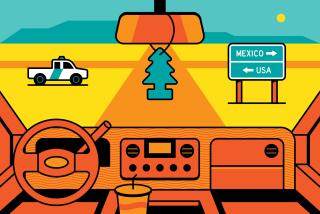The Big Bang : Business booms all year round at the nation’s biggest fireworks stand.
- Share via
SOUTH OF THE BORDER, S.C. — This offbeat place, just south of the North Carolina line on Interstate 95 midway between New York and Miami, boasts the biggest fireworks stand in America.
Given the time of year, sales have been booming.
“Last year, we sold $5 million worth of skyrockets, Roman candles, firecrackers, sparklers, every kind of legal fireworks available anywhere in the United States,” said 75-year-old Alan Schafer, the entrepreneur who runs South of the Border. “This year we’ll sell even more.”
Schafer, who created the roadside phenomenon 40 years ago, said: “I’m the whole shooting match here. I own the place--lock, stock and barrel.” His 135-acre spread has six restaurants, 14 gift shops, 125 campsites, a 300-room motel, a convention center that seats 750, a drugstore, pastry shop, bank, post office, bingo parlor, nine-hole golf course, miniature golf course, amusement park and its own police and fire departments.
Emblazoned on the water tower are South of the Border’s official initials: SOB.
Although it is 1,500 miles from Mexico, the place has a Mexican theme. The restaurants, for example, include Las Maracas, Ole Cafe, Hot Tamale and Pedro’s Diner. Glass elevators whisk visitors to the top of the 24-story Sombrero Tower for a view of South of the Border from the rim of a gigantic Mexican hat.
Two hundred colorful billboards featuring South of the Border’s symbol, a stereotypical Mexican character named Pedro with huge sombrero and flowing mustache, line Interstate 95 from Virginia through the Carolinas to Georgia.
“Last year’s total sales in South of the Border exceeded $30 million,” Schafer said. “An estimated 7.5 million people stopped here, with each man, woman and child spending an average of $4.”
And the fireworks, which Schafer sells all year in his huge Fort Pedro fireworks department store, are bestsellers--last year representing about one-sixth of South of the Border’s sales.
“Truck drivers on regular runs through here often load up with $1,000 and more in fireworks and bootleg them in states where they are prohibited, charging three to four times what they pay in SOB. Many college students have told me they pay their way through school buying fireworks here and reselling them elsewhere,” Schafer said.
Hottest times for fireworks sales, he added, are the periods before Independence Day and December. Southerners set off almost as many fireworks at Christmas and on New Year’s Eve as they do on July 4.
South of the Border--a roadside stop in the middle of nowhere--has 600 year-round workers and another 200 employees during summer. But nobody lives here.
But Schafer’s family has lived in the general area for 130 years, and his grandfather, Abraham Schafer, opened a crossroads store near here in 1870. In 1949, seizing an opportunity that presented itself when North Carolina voted to ban liquor sales, Schafer bought three acres of land just south of that state’s border and opened a beer store.
He put up a big sign that proclaimed the place to be South of the Border.
“There was no thought about the Mexican theme at the time, just the fact that beer was available south of the border. Because of the sign, however, people would always ask: ‘Where’s Juan?’ ‘Where’s Pedro?’ ‘Where’s Jorge?’ I opened a small cafe, next the souvenir stand, then it hit me: Go with a Mexican theme,” Schafer recalled.
T-Shirts Sell Well
He said he imports only 10% of his merchandise from Mexico “because I have a tough time getting deliveries on time. So, I buy Mexican imitations in the Orient, Mexican straw hats marked Made in Taiwan, for example; Mexican ceramics, made in Hong Kong. I wish I could get all of it out of Mexico.”
Schafer’s biggest profit comes from the T-shirts--featuring, among other things, drawings of Pedro and the SOB initials--that are sold in his shops. “I sell 100,000 dozen a year--more than 1.2 million,” he said.
“Three Southern knitting mills supply the T-shirts,” he said. However, “it’s not the T-shirts, but what’s printed on them that sell.”
So Schafer, who is always opening something new in this misplaced bit of Mexico in the middle of the Carolinas, said: “I’m opening my own T-shirt printing plant soon.”
More to Read
Sign up for The Wild
We’ll help you find the best places to hike, bike and run, as well as the perfect silent spots for meditation and yoga.
You may occasionally receive promotional content from the Los Angeles Times.






